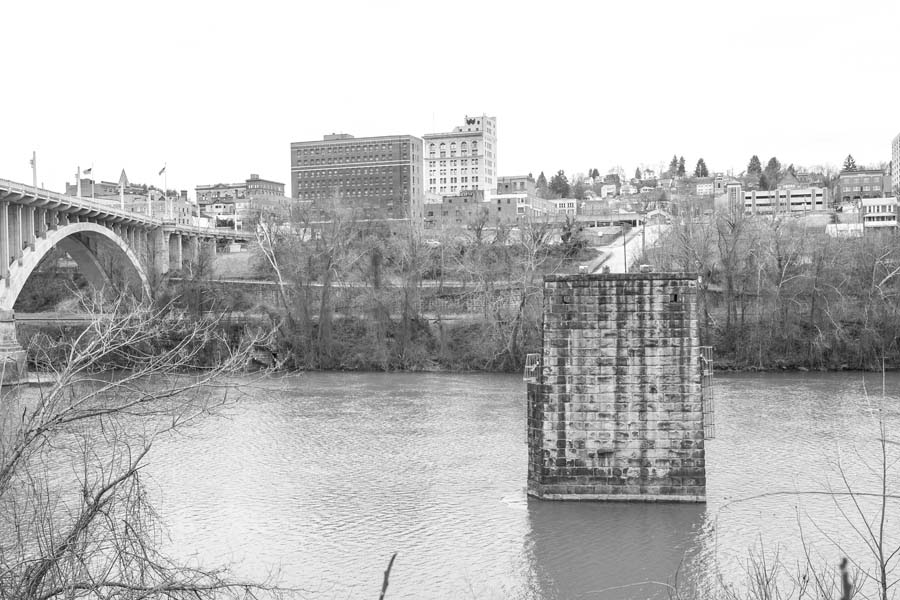Hidden in Plain Sight
Marion County's Civil War-Era Landmarks
By Shannon Tinnell

This pylon in the Monongahela River at Fairmont dates back to the mid-19th century, when it helped to support the Suspension Bridge, connecting Fairmont and Palatine, now known as East Fairmont. Photograph by Addie and Chelsie Photo.
Daily we drive or walk past significant historical sites that played instrumental roles in not only the formation and history of West Virginia, but the nation as well. Sometimes we are fortunate enough to still be able to touch, see, and smell them. Marion County has managed to preserve a number of structures that were standing during the Civil War, including the Job Prickett House at Prickett’s Fort, the George Pinkney Morgan House in Rivesville, the Worthington Dam, the Fleming House (preserved beneath a modern exterior), and the Barrackville Covered Bridge. The 1870 fire destroyed many of the businesses and homes that witnessed the Battle of Fairmont, and time and progress have erased most of the rest. Yet, if you take a moment to stand and study the landscape, you can indeed still see things as they were, hidden in plain sight.
During the decades prior to the Civil War, Fairmont grew at a slow and steady rate, driven primarily by the agrarian pursuits of area residents. However in 1852, two events changed the landscape of Fairmont forever. First, the Beverly-Fairmont Turnpike was completed. This gravel road improved transportation to and from the city and connected it, via the Staunton-Parkersburg Turnpike, to old Virginia. Then, a second and considerably more transformational event occurred: the Baltimore & Ohio Railroad reached Fairmont, opening up industries such as coal, oil, and timber to other markets and stimulating economic growth.
In 1852, a suspension bridge was constructed across the Monongahela River, with a span of 650 feet, connecting Fairmont to Palatine (now East Fairmont) and carrying foot, wagon, and livestock traffic. That same year, the imposing Baltimore & Ohio Railroad Bridge was completed. Before and after the Civil War, these improvements to transportation infrastructure were key factors in opening Fairmont up to industrial markets and westward expansion. During the war, however, they became strategically important to both North and South, and that importance led to the Battle of Fairmont, a significant event within the larger military exercise known as the Jones-Imboden Raid.
While the majority of western Virginia was pro-Union (more 32,000 people), there were also a number of Confederate sympathizers in the area (around 10,000). Marion County was the quintessential border county, where political differences often pitted neighbor against neighbor, family member against family member. Being home to Francis Harrison Pierpont, governor of the Restored Government of Virginia, heightened the county’s importance from merely tactical to symbolic. Pierpont was extremely unpopular amongst the Confederacy and presented a tantalizing target for Southern forces. That, coupled with the strategically important Fairmont railroad bridge (which gave the Baltimore & Ohio Railroad access across the Monongahela), thrust the county, and Fairmont in particular, into the sights of Confederate General William E. “Grumble” Jones.
Between April 24 and May 22, 1863, Confederate cavalry under the command of Jones and General John D. Imboden set out on a destructive raid throughout western Maryland and north-central western Virginia with the goal to weaken Union control in the area by destroying the Baltimore & Ohio Railroad and the infrastructures supporting the railroad. The invaders swept through, wiping out as much infrastructure as possible and plundering food and supplies from local citizens.
On April 28, 1863, Jones’ forces entered Fairmont from the west side of the town, coming down Hamilton Hill and Reed’s Knob, and initiated the battle that bears the city’s name. Here General Jones divided his troops, sending one group into the downtown business district, which ultimately led to their skirmish with Union forces at the suspension bridge.
Greatly outnumbered, the retreating Yankees tore up the suspension bridge’s floor boards to slow the attacking force. However, the Rebels proceeded to put them back down and managed to shoot their way across. The beleaguered Union soldiers took cover in a stone building near the far end of the bridge but ultimately surrendered to the Confederates.
Here we encounter the first of the landmarks “hidden in plain sight.” The suspension bridge served the city for more than 50 years. By the early 1900’s, however, a replacement was deemed necessary. The suspension bridge was razed, and a steel girder bridge, known locally as the “Nickel” or “low-level” bridge, took its place. This bridge stood until late in the 20th century when it, too, was removed. However, if you look closely at the bottom of Madison Street near the railroad tracks, you will find that two of the original pylons of the suspension bridge remain standing. A Civil War Trails sign identifies the pylons and the fact that you can still find the scars of gunfire from the Battle of Fairmont.
You can read the rest of this article in this issue of Goldenseal, available in bookstores, libraries or direct from Goldenseal.